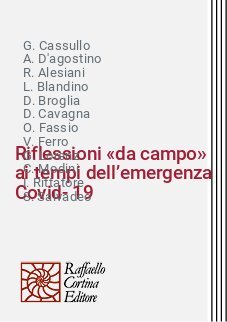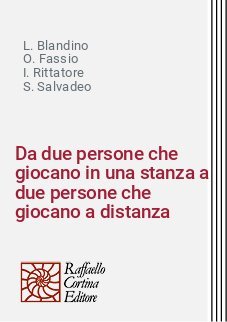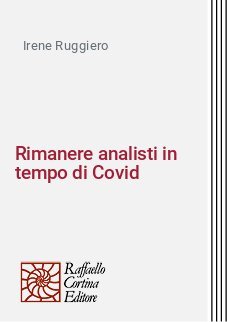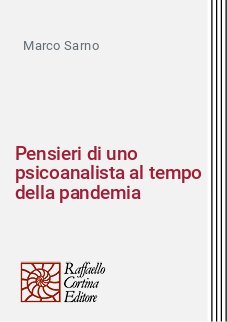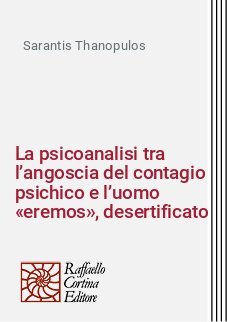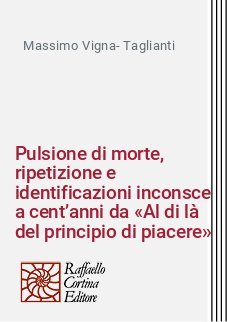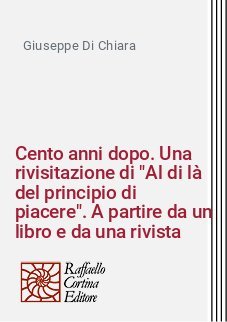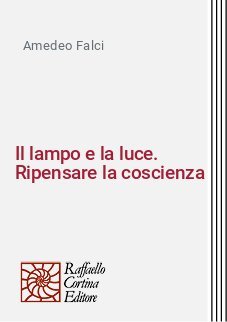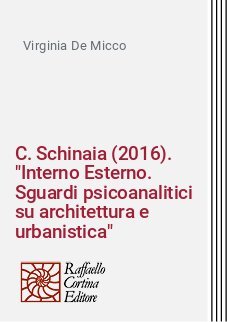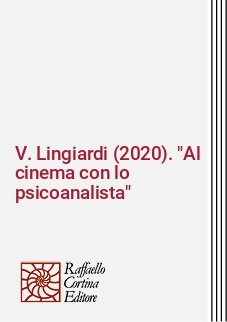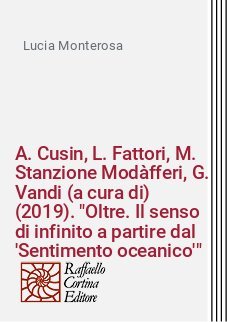Raffaello Cortina Editore
Riflessioni "da campo" ai tempi dell’emergenza Covid-19
rivista: La Rivista di Psicoanalisi
fascicolo: Rivista di Psicoanalisi 2020/4
Autori vari
Riflessioni «da campo» ai tempi dell’emergenza Covid-19
Questo lavoro racconta la nostra esperienza di gruppo in remoto su Zoom in tempo di emergenza da Covid-19, nata al fine di promuovere riflessioni «da campo» sullo stato di emergenza che stavamo vivendo. I paragrafi descrivono i vari temi emersi negli incontri: 1) la specificità traumatica dell’emergenza Covid-19; 2) il lavoro da remoto; 3) simmetria, asimmetria e realtà; 4) confini, sconfinamenti e nuovi scenari; 5) l’istituzione psicoanalitica, l’emergenza e il dopo; 6) riflessioni finali sulla scrittura in gruppo.
Parole-chiave: Lavoro da remoto, lockdown Covid-19, riflessioni «da campo», trauma.
«Field» reflections at the time of Covid-19 emergency. This work recounts our Zoom meetings held during the months of Covid-19 lockdown and born in order to promote «camp» reflections on the state of emergency we were experiencing. The paragraphs describe the various themes emerging from the meetings: 1) the traumatic specificity of the Covid-19 emergency; 2) remote working; 3) symmetry, asymmetry, and reality; 4) borders, boundaries, and new scenarios; 5) the psychoanalytic institution, the emergency, and the aftermath; 6) final reflections on group writing.
Keywords: «Camp» reflections, Covid-19 lockdown, remote working, trauma.
Réflexions «de camp» au moment de l’urgence Covid-19. Cet ouvrage retrace notre expérience de groupe à distance sur «Zoom» en temps d’urgence du COVID-19, né pour favoriser des réflexions «de camp» sur l’état d’urgence que nous vivions. Les paragraphes décrivent les différents thèmes qui ont émergé au cours des réunions: 1) la spécificité traumatique de l’urgence Covid-19; 2) travail à distance; 3) symétrie, asymétrie et réalité; 4) frontières, empiétements et nouveaux scénarios; 5) l’institution psychanalytique, l’urgence et l’après; 6) réflexions finales sur l’écriture de groupe.
Mots clés: Réflexions sur le camp, traumatisme, travail à distance, verrouillage du Covid-19.
Reflexiones «de campo» en tiempos de la emergencia Covid-19. Este trabajo relata nuestra experiencia grupal, a distancia desde Zoom, en tiempo de emergencia del COVID-19, nacida con el fin de promover reflexiones «de campo» sobre el estado de emergencia que estamos viviendo. Los párrafos describen los diversos temas que surgieron en las reuniones: 1) la especificidad traumática de la emergencia Covid-19; 2) el trabajo a distancia; 3) simetría, asimetría y realidad; 4) fronteras, invasiones y nuevos escenarios; 5) la institución psicoanalítica, la emergencia y después; 6) Reflexiones finales sobre escritura grupal.
Palabras clave: Covid-19, lockdown, reflexiones «de campo», trabajo a distancia, trauma.
Überlegungen «aus dem Feld» zu Zeiten des Covid-19-Notstandes. Diese Arbeit berichtet von unserer Erfahrung als Gruppe aus der Distanz über Zoom zur Zeit des Covid-19-Notstandes mit dem Ziel, Überlegungen «aus dem Feld» über den Zustand des Notstandes, den wir erleben, anzustoßen. Die Absätze beschreiben die verschiedenen Themen, die in den Treffen zutage gekommen sind: 1) Die traumatische Besonderheit des Covid-19-Notstandes; 2) Die Arbeit aus der Distanz; 3) Symmetrie, Asymmetrie und Realität; 4) Grenzen, Grenzübertritte und neue Szenarien; 5) Die psychoanalytische Institution, der Notstand und das Danach; 6) Schlussüberlegungen zum Schreiben in der Gruppe.
Schlüsselwörter: Arbeit aus der Distanz, «aus dem Feld», Covid-19-Lockdown, Trauma, Überlegungen.
Da due persone che giocano in una stanza a due persone che giocano a distanza
rivista: La Rivista di Psicoanalisi
fascicolo: Rivista di Psicoanalisi 2020/4
Autori vari
Da due persone che giocano in una stanza a due persone che giocano a distanza
Nel presente scritto, dopo una breve analisi della letteratura riguardante il tema del lavoro da remoto, vengono esposte alcune riflessioni sull’impatto che l’uso di strumenti tecnologici ha avuto sul setting e sulle capacità rappresentative di due bambini in terapia durante il Covid-19.
Parole chiave: Bambini, Covid-19, setting, Skype.
by two people playing in a room to two people playing at a distance. In this paper, after a brief analysis of the literature on the topic of psychoanalytical remote work, some reflections are presented on the impact that the use of technological tools had on the clinical setting and on the representative abilities of two children in therapy during the Covid-19.
Key words: Children, Covid-19, setting, Skype.
De deux personnes jouant dans une pièce à deux personnes jouant à distance. Dans cet article, après une brève analyse de la littérature sur le thème du travail à distance, quelques réflexions sont présentées sur l’impact que l’utilisation des outils technologiques a eu sur le setting et sur les capacités représentatives de deux enfants en thérapie pendant la pandémie de Covid-19. .
Mots clés: Cadre, Covid-19, enfants, Skype.
De dos personas que juegan en una habitación hacia dos personas que juegan a distancia. En este artículo, luego de un breve análisis de la literatura sobre el tema del trabajo a distancia, se presentan algunas reflexiones sobre el impacto que ha tenido el uso de herramientas tecnológicas en el setting y en las capacidades representativas de dos niños en terapia durante el Covid-19.
Palabras clave: Covid-19, niños, setting, Skype.
Von zwei Personen, die in einem Zimmer spielen, zu zwei Personen, die aus der Distanz spielen. Im vorliegenden Aufsatz werden nach einer kurzen Analyse der Literatur zum Thema der Arbeit aus der Distanz einige Überlegungen zur Wirkung angestellt, die der Gebrauch technologischer Instrumente auf das Setting und auf die Repräsentationsfähigkeiten zweier Kinder gehabt hat, die während Covid-19 in Therapie waren.
Schlüsselwörter: Covid-19, Kinder, Setting, Skype.
Rimanere analisti in tempo di Covid
rivista: La Rivista di Psicoanalisi
fascicolo: Rivista di Psicoanalisi 2020/4
di Irene Ruggiero
Rimanere analisti in tempo di Covid
L’autrice ripercorre le opzioni operative con le quali l’improvvisa esplosione della pandemia ci ha costretti a confrontarci come analisti, cimentati con il difficile compito di conciliare la fedeltà al metodo psicoanalitico con le necessità della cura; ed esplora le complesse ripercussioni etiche connesse alle differenti scelte (continuare a lavorare in presenza; sospendere i trattamenti fino a che non fosse possibile ripristinare il setting analitico tradizionale; lavorare in remoto, con accomodamenti estesi del setting usuale). Si interroga infine sulla situazione attuale e sugli elementi traumatici connessi alla uscita dal lockdown, evidenziando come l’eventuale ritorno ad un lavoro in presenza non possa comunque essere un ritorno all’origine.
Parole chiave: Covid-19, etica psicoanalitica, metodo analitico, setting.
remain analysts in Covid time. The author discusses the practical options that the sudden explosion of the pandemic forced us to deal with as analysts. She reflects on the difficult task of reconciling the challenge of remaining true to the psychoanalytical method with the need for treatment. She explores the complex ethical repercussions connected to each of the different choices (to continue working only in physical presence; to suspend all treatments until it is possible to return to the traditional analytical setting; to work remotely with extensive compromise to the usual setting). She concludes with reflections on the current situation and the traumatic aspects of coming out of lockdown, highlighting how even returning to working in presence nevertheless cannot be a return to the origin.
Key words: Covid-19, psychoanalytic ethics, psychoanalytical method, setting.
Rester des analystes en temps de Covid. L’auteur retrace les options opérationnelles avec lesquelles l’explosion soudaine de la pandémie nous a obligés à nous confronter en tant qu’analystes, interpellés par la difficile tâche de concilier fidélité à la méthode psychanalytique et nécessité du traitement; elle explore les complexes répercussions éthiques liées aux différents choix (continuer à travailler en présence; suspendre les traitements jusqu’à ce qu’il soit possible de restaurer le setting analytique traditionnel; travailler à distance, avec des aménagements prolongés du setting habituel). Enfin, elle interroge la situation actuelle et les éléments traumatiques liés au déconfinement, soulignant comment tout retour à un travail en présence ne peut en aucun cas être un retour à l’origine.
Mots Clés: Covid-19, etique psychanalytique, méthode psychanalytique, setting psychanalytique.
Permanecer analistas en tiempos de Covid. La autora hace un recorrido a través de las opciones operativas con las que la repentina explosión de la pandemia nos ha obligado a enfrentarnos como analistas, lidiando con la difícil tarea de conciliar la fidelidad al método psicoanalítico con la necesidad de tratamiento; y explora las complejas repercusiones éticas relacionadas con las diferentes opciones (continuar trabajando en presencia; suspender los tratamientos hasta que sea posible restaurar el setting analítico tradicional; trabajar a distancia, con adaptaciones que extienden el setting habitual). En conclusión se interroga sobre la situación actual y sobre elementos traumáticos relacionados con la salida del lockdown, destacando cómo un eventual retorno al trabajo en presencia no pueda ser en ningún caso un retorno al origen.
Palabras clave: Covid-19, ética psicoanalítica, método analítico, setting.
Analytiker bleiben in Zeiten von Covid. Die Verfasserin vollzieht die Handlungsoptionen nach, mit denen uns auseinanderzusetzen der plötzliche Ausbruch der Pandemie uns als Analytiker gezwungen hat, die wir von der schwierigen Aufgabe herausgefordert sind, die Treue zur psychoanalytischen Methode mit der Notwendigkeit der Behandlung zu vereinbaren; zudem untersucht sie die komplexen ethischen Auswirkungen, die an die verschiedenen Entscheidungen gebunden sind (in Präsenz weiterzuarbeiten; Behandlungen einzustellen, bis es möglich ist, das traditionelle analytische Setting wiederherzustellen; aus der Distanz zu arbeiten, mit umfassenden Anpassungen des üblichen Settings). Sie fragt zuletzt nach der aktuellen Situation und den traumatischen Elementen, die mit dem Verlassen des Lockdowns verbunden sind und hebt hervor, inwiefern die Rückkehr zur Arbeit in Präsenz letztlich keine Rückkehr zum Ursprung sein kann.
Schlüsselwörter: Analytische Methode, Covid-19, psychoanalytische Ethik, Setting.
Pensieri di uno psicoanalista al tempo della pandemia
rivista: La Rivista di Psicoanalisi
fascicolo: Rivista di Psicoanalisi 2020/4
di Marco Sarno
Pensieri di uno psicoanalista al tempo della pandemia
La pandemia da Covid19 ha impattato e non travolto il lavoro dello psicoanalista e dei suoi pazienti. Questo anche perché l’etica della cura è ancorata allo specifico della responsabilità, che fonda il percorso di soggettivazione. Nel micro-livello della seduta, le congiunzioni oppositive rappresentano lo snodo del movimento fra simmetria e asimmetria, alludendo all’accettazione e trasformazione del trauma. L’eclisse dei corpi, asfaltati dalla dimensione televisiva di Skype, è occasione per riflettere sulle disarmonie fra mente e corpo anche nel normale setting, evidenziando le risposte stereotipate che l’analista rischia di offrire. Il riferimento al Decameron, consente un itinerario di corrispondenze fra la struttura del capolavoro di Boccaccio e alcuni temi-chiave del lavoro psicoanalitico, quali contenitore/contenuto, racconto, oralità/scrittura, Eros/Thanatos, caducità.
PAROLE CHIAVE: Contagio/contatto, corpi, Decameron, etica, orale/scritto, pandemia, trauma.
Thoughts of a psychoanalyst at the time of the pandemic. The Covid19 pandemic impacted and did not overwhelm the work of the psychoanalyst and his patients. This is also because the ethics of care is anchored in the specifics of responsibility, which underpins the path of subjectification. In the micro-level of the session, the oppositional conjunctions represent the junction of the movement between symmetry and asymmetry, alluding to the acceptance and transformation of trauma. The eclipse of bodies, asphalted by the television dimension of Skype, is an opportunity to reflect on the disharmonies between mind and body even in the normal setting, highlighting the stereotyped answers that the analyst risks offering. The reference to the Decameron, allows an itinerary of correspondence between the structure of Boccaccio’s masterpiece and some key themes of psychoanalytic work, such as container/content, story, orality/writing, Eros/Thanatos, transience.
KEYWORDS: Contagion/contact, bodies, Decameron, ethics, oral/written, pandemic, trauma.
Réflexions d’un psychanalyste au moment de la pandémie. La pandémie de Covid19 a impacté et non submergé le travail du psychanalyste et de ses patients. C’est aussi parce que l’éthique du traitement est ancrée dans les spécificités de la responsabilité, qui sous-tendent le chemin de la subjectivation. Au micro-niveau de la séance, les conjonctions oppositionnelles représentent la jonction du mouvement entre symétrie et asymétrie, faisant allusion à l’acceptation et à la transformation du traumatisme. L’éclipse des corps, pavée par la dimension télévisuelle de Skype, est l’occasion de réfléchir sur la disharmonie entre l’esprit et le corps même dans le setting normal, mettant en évidence les réponses stéréotypées que l’analyste risque d’offrir. La référence au Décaméron permet un itinéraire de correspondances entre la structure du chef-d’œuvre de Boccaccio et certains thèmes clés de l’œuvre psychanalytique, tels que le contenant / contenu, l’histoire, l’oralité / l’écriture, Eros / Thanatos, l’éphémère.
MOT-CLÉS: Contagion / contact, corps, Décaméron, éthique, oral / écrit, pandémie, traumatisme.
Reflexiones de un psicoanalista en tiempos de pandemia. La pandemia de Covid19 ha impactado pero non ha arrasado el trabajo del psicoanalista y de sus pacientes. Esto también se debe a que la ética de la cura está anclada a la especificidad de la responsabilidad, que funda el camino de la subjetivación. En el micro nivel de la sesión, las conjunciones oposicionistas representan la articulación del movimiento entre simetría y asimetría, aludiendo a la aceptación y transformación del trauma. El eclipse del cuerpos, sostenido por la dimensión televisiva de Skype, es una oportunidad para reflexionar sobre las desarmonías entre mente y cuerpo en el setting normal, destacando las respuestas estereotipadas que el analista se arriesga a ofrecer. La referencia al Decameron permite un itinerario de correspondencias entre la estructura de la obra maestra de Boccaccio y algunos temas clave de la obra psicoanalítica, como contenedor / contenido, relato, oralidad / escritura, Eros / Thanatos, decadencia.
PALABRAS CLAVE: Contagio / contacto, cuerpos, Decameron, ética, oral / escrito, pandemia, trauma.
Gedanken eines Psychoanalytikers in Zeiten der Pandemie. Die Covid-19-Pandemie hat die Arbeit des Psychoanalytikers und seiner Patienten beeinträchtigt und nicht überwältigt. Dies auch weil die Ethik der Behandlung verankert ist im Spezifikum der Verantwortung, die den Weg der Subjektivierung begründet. Auf der Mikroebene der Sitzung stellen die oppositiven Verbindungen den Schnittpunkt der Bewegung zwischen Symmetrie und Asymmetrie dar und zielen auf die Akzeptanz und Transformation des Traumas. Die Verdunklung der Körper, asphaltiert durch die fernsehartige Dimension von Skype, ist Anlass über die Disharmonien zwischen Geist und Körper auch im normalen Setting nachzudenken und die stereotypen Antworten hervorzuheben, die der Analytiker anzubieten riskiert. Der Verweis auf das Decamerone ermöglicht einen Weg der Korrespondenzen zwischen der Struktur von Boccaccios Meisterwerk und einigen Schlüsselthemen der psychoanalytischen Arbeit wie Behälter/Inhalt, Erzählung, Mündlichkeit/Schriftlichkeit, Eros/Thanatos, Vergänglichkeit.
Schlüsselwörter: Ansteckung/Kontakt, Körper, Decamerone, Ethik, mündlich/schriftlich, Pandemie, Trauma.
La psicoanalisi tra l’angoscia del contagio psichico e l’uomo "eremos", desertificato
rivista: La Rivista di Psicoanalisi
fascicolo: Rivista di Psicoanalisi 2020/4
di Sarantis Thanopulos
La psicoanalisi tra l’angoscia del contagio psichico e l’uomo «eremos», desertificato
La pandemia Covid mette a dura prova il lavoro degli analisti, obbligandoli a ricorrere in gran parte allo Smart Working. La soluzione di emergenza consente la continuità del lavoro di cura, grazie anche al sentimento di reciproca mancanza e solidarietà che si è creato all’interno della relazione analitica. Ha messo, al tempo stesso, in evidenza la minaccia che rappresenta per la psicoanalisi il continuo stato di emergenza in cui vive l’intero mondo. Lo distanziamento sociale, dominante, da molto tempo, nella nostra vita, si allea con la chiusura nei confronti degli altri, che la paura del contagio favorisce, e crea una diffidenza nei confronti del coinvolgimento erotico, affettivo e mentale, un’angoscia del contagio psichico che si diffonde tra di noi come virus psichico. Gli psicoanalisti hanno una grande responsabilità di fronte a un processo di desertificazione delle relazioni che trasforma la solitudine in desolazione.
Parole chiave: Coinvolgimento, desolazione, solitudine, virus.
The psychoanalysis between the anguish of psychic contagion and the «eremos» man, desertified. The Covid pandemic is a hard test for analysts. Obliges them to use, for the most, smart working. The emergency solution saves the continuity of the cure, thanks to the feeling of reciprocal missing and solidarity between analysts and patients. At the same time it became evident that the constant state of emergency in which lives the entire world represents a threat for psychoanalysis. The social distancing, that has being dominated our life for a lot of time, co-produces along with the closure towards the others (facilitated by the fear of the infection) a diffidence against the erotic, emotional, mental involvement: a fear of psychic contagion which spreads among us psychic virus. Analysts have a great responsibility dealing with a process of desertification of relationships that transforms solitude in loneliness.
KEY WORDS: Involvement, desolation, loneliness, virus.
Psychanalyse entre l’angoisse de la contagion psychique et l’homme «eremos», désertifié. La pandémie de Covid met à dure épreuve le travail des analystes, les obligeant à recourir largement au Smart Working. La solution d’urgence permet la continuité du travail de soin, grâce aussi au sentiment de manque mutuel et de solidarité qui s’est créé au sein de la relation analytique. Dans le même temps, il a souligné la menace posée à la psychanalyse par l’état d’urgence continu dans lequel vit le monde entier. La distanciation sociale, qui a longtemps été dominante, dans notre vie, est alliée à la fermeture aux autres, que la peur de la contagion favorise, et crée une méfiance à l’égard de l’implication érotique, émotionnelle et mentale, une angoisse de contagion psychique qui se propage parmi nous comme un virus psychique. Les psychanalystes ont une grande responsabilité face à un processus de désertification des relations qui transforme la solitude en désolation.
MOTS CLÉS: Désolation, implication, solitude, virus.
Psicoanálisis entre la angustia del contagio psíquico y el hombre «eremos», desertificado. La pandemia de Covid pone a prueba el trabajo del psicoanalista y lo obliga a recurrir en gran medida al Smart Working. La solución de emergencia permite la continuidad del trabajo de cura, también gracias al sentimiento de falta recíproca y de solidaridad que ha sido creado dentro de la relación analítica. Al mismo tiempo puso en evidencia la amenaza que representa para el psicoanálisis, el continuo estado de emergencia en el que vive todo el mundo. El distanciamiento social, dominante en nuestra vida durante mucho tiempo, se ha aliado al cerrarse en la relación con los otros, que además, el temor del contagio favorece, generando una desconfianza respecto a la implicación erótica, emocional y mental, una angustia de contagio psíquico que se propaga entre nosotros como un virus psíquico. Los psicoanalistas tienen una gran responsabilidad ante un proceso de desertificación de las relaciones que transforma la soledad en desolación.
PALABRAS CLAVE: Desolación, implicación, soledad, virus.
Die Psychoanalyse zwischen der Angst vor der psychischen Ansteckung und dem einsamen, desertifizierten Menschen. Die Covid-Pandemie stellt die Arbeit der Analytiker auf eine harte Probe, indem es sie zwingt, zum großen Teil auf das Smart Working zurückzugreifen. Die Lösung des Notstandes erlaubt die Kontinuität der Behandlungsarbeit auch dank des Gefühls des wechselseitigen Fehlens und der Solidarität, das innerhalb der analytischen Beziehung entstanden ist. Zugleich hat sie die Bedrohung hervorgehoben, die der andauernde Ausnahmezustand, in dem die ganze Welt lebt, für die Psychoanalyse darstellt. Das Social Distancing, das seit langer Zeit unser Leben beherrscht, verbündet sich mit der Verschlossenheit in der Gegenüberstellung mit den anderen, die durch Angst vor der Ansteckung befördert wird, und schafft in den Gegenüberstellungen ein Misstrauen gegenüber erotischer, affektiver und mentaler Verwicklung, eine Angst vor der psychischen Ansteckung, die sich unter uns verbreitet als ein psychisches Virus. Die Psychoanalytiker tragen große Verantwortung angesichts eines Prozesses der Desertifikation der Beziehungen, der die Einsamkeit in Verlassenheit wandelt.
Schlüsselwörter: Einsamkeit, Verwicklung, Verlassenheit, Virus.
Pulsione di morte, ripetizione e identificazioni inconsce a cent’anni da "Al di là del principio di piacere"
rivista: La Rivista di Psicoanalisi
fascicolo: Rivista di Psicoanalisi 2020/4
di Massimo Vigna-Taglianti
Pulsione di morte, ripetizione e identificazioni inconsce a cent’anni da Al di là del principio di piacere
Nel corso di questo lavoro verranno presi in esame alcuni degli aspetti concettuali trattati in Al di là del principio di piacere, declinandoli alla luce dei molteplici sviluppi teorici avvenuti nei cento anni successivi alla pubblicazione del testo freudiano. In particolare verrà illustrata l’ipotesi che alcune manifestazioni cliniche – ritiri schizoidi, quadri depressivi, organizzazioni patologiche, personalità «as if», perversioni, zone morte – possano trarre origine là dove il Sé sia stato vittima di precoci e ripetute interazioni primarie caratterizzate da una consistente mortificazione e umiliazione dell’amore di sé e del senso di esistere, con conseguente introiezione di relazioni oggettuali che si traducono in un istinto mortifero e muto – una passione di morte più che una pulsione di morte innata – che «sterilizza» i nessi affettivi provocando alterazioni della consapevolezza e un viraggio dei meccanismi di difesa e di sopravvivenza psichica non solamente al di là del principio di piacere ma anche al di là della rimozione, verso la scissione e la dissociazione.
Parole Chiave: Funzioni trasformative dell’analista, pulsione di morte, ripetizione e identificazioni inconsce.
Death drive, repetition and unconscious identifications hundred years Beyond the pleasure principle. In this paper some of the conceptual aspects dealing with Beyond the Pleasure Principle will be examined in the light of the many theoretical developments that have taken place in the hundred years since the publication of the Freudian text. In particular, we will illustrate the hypothesis that some clinical manifestations – schizoid retreats, depressive manifestations, personality as if, perversions dead zones – may originate when the Self has been victim of early and repeated primary interactions characterised by a consistent mortification and humiliation of self-love and sense of existing, with consequent introjection of object relations that give rise to a deadly and mute instinct – a passion for death rather than an innate death drive – that «sterilises» the affective links causing alterations in awareness and a shift of defence mechanisms and of psychic survival not only beyond the principle of pleasure but also beyond repression, towards splitting and dissociation.
KEY WORDS: Death drive, repetition and unconscious identifications, tranformative functions of analyst.
Pulsion de mort, répétition et identifications inconscientes à cent ans d’Au-delà du principe de plaisir. Au cours de ce travail, certains aspects conceptuels traités dans Au-delà du principe du plaisir seront examinés, en les déclinant à la lumière des nombreux développements théoriques qui ont eu lieu dans les cent ans qui ont suivi la publication du texte freudien. En particulier, l’hypothèse sera illustrée que certaines manifestations cliniques – retraites schizoïdes, cadres dépressifs, organisations pathologiques, personnalité «comme si». perversions, zones mortes – peuvent prendre naissance là où le Soi a été victime d’interactions primaires précoces et répétées caractérisées par une mortification et une humiliation constantes de l’amour-propre et du sens de l’existence, avec une introjection conséquente des relations d’objet qui se traduisent par un instinct mortel et muet – une passion de mort plutôt qu’une pulsion de mort innée – qui «stérilise» les liens affectifs provoquant des altérations de la conscience et un changement des mécanismes de défense et de survie psychique non seulement au-delà du principe de plaisir mais aussi au-delà du refoulement, vers le clivage et la dissociation.
Mots Clés: Fonctions transformatrices de l’analyste, pulsion de mort, répétition et identifications inconscientes.
Pulsión de muerte, repetición e identificaciones inconscientes a cien años de Más allá del principio del placer. En este trabajo se examinarán algunos aspectos conceptuales tratados en Más allá del principio del placer, declinándolos a la luz de los múltiples desarrollos teóricos surgidos en los cien años sucesivos a la publicación del texto freudiano. En particular, se ilustrará la hipótesis de que algunas manifestaciones clínicas – retiros esquizoide, cuadros depresivos, organizaciones patológicas, personalidad «as if», perversiones, zonas muertas – puedan originarse donde el Sè haya sido víctima de interacciones primarias precoces y repetidas caracterizadas por una mortificación y humillación significativa del amor de si mismo y del sentido de la existencia, con la consiguiente introyección de relaciones de objeto que dan como resultado un instinto mortífero y mudo: una pasión de muerte más que una pulsión de muerte innata – que «esteriliza» los vínculos afectivos provocando alteraciones de la conciencia y un viraje en los mecanismos de defensa y de supervivencia psíquica que no solo van más allá del principio del placer sino también más allá de la represión, hacia la escisión y la disociación.
Palabras clave: Funciones transformativas del analista, pulsión de muerte, repetición e identificaciones inconscientes.
Todestrieb, Wiederholung und unbewusste Identifikationen hundert Jahre nach Jenseits des Lustprinzips.Im Laufe dieser Arbeit werden einige der in Jenseits des Lustprinzips behandelten begrifflichen Aspekte geprüft und auf der Grundlage der vielfältigen theoretischen Entwicklungen in den hundert Jahren nach der Veröffentlichung des Freud’schen Textes zurückgewiesen. Insbesondere wird die Hypothese veranschaulicht, dass manche klinischen Manifestationen – schizoide Rückzüge, depressive Raster, pathologische Organisationen, ‚Als-Ob‘-Persönlichkeit, Perversionen, tote Zonen – sich von dort herleiten lassen können, wo das Selbst Opfer frühkindlicher und wiederholter Primärinteraktionen geworden ist, die sich durch eine beständige Demütigung und Kränkung der Liebe zum Selbst und zum Sinn der Existenz kennzeichnen, mit daraus folgender Introjektion von Objektrelationen, die sich in einen tödlichen und stummen Instinkt übersetzen – eher eine Todespassion als ein angeborener Todestrieb –, der die affektiven Verbindungen «sterilisiert» und Veränderungen des Bewusstseins sowie eine Wendung der Mechanismen der Abwehr und des psychischen Überlebens nicht nur jenseits des Lustprinzips, sondern auch jenseits der Verdrängung bewirkt, hin zur Spaltung und zur Dissoziation.
Schlüsselwörter: Todestrieb, Transformative Funktionen des Analytikers, Wiederholung und unbewusste Identifikationen.
Cento anni dopo. Una rivisitazione di "Al di là del principio di piacere". A partire da un libro e da una rivista
rivista: La Rivista di Psicoanalisi
fascicolo: Rivista di Psicoanalisi 2020/4
di Giuseppe Di Chiara
Cento anni dopo. Una rivisitazione di Al di là del principio di piacere. A partire da un libro e da una rivista
Il tempo non ha smorzato la conflittualità attorno ai principali contenuti di Al di là del principio di piacere, e cioè la pulsione di morte e il masochismo primario. Viene proposta una breve rassegna dei punti controversi. L’autore suggerisce una possibile origine della teoria di Freud della pulsione di morte, come l’esito di un lutto. L’Io, venuto a conoscenza della fine inevitabile del corpo, vive sentimenti insopportabili di sconforto. Odia il proprio corpo e ne prende le distanze. L’Io avvia un processo di lutto e, seguendo l’usuale percorso, introietta un corpo oggetto psichico odiato e minaccioso, che è il nucleo centrale della pulsione di morte. La teoria aiutò Freud a superare il suo momento critico, ma ha fragili radici scientifiche.
Parole Chiave: Biologia, corpo, depressione, Eros, lutto, masochismo, metodo, odio, oggetto psichico, pulsione aggressiva, pulsione di morte, rappresentazioni, Thanatos.
One Hundred Years After Its Pubblication A Revising Of Freud’ Beyond The Pleasure Principle. Time does not have reduced the conflict about the main contents of the Freud’s work of 1920,i.e. the death instinct and primary masochism. A short review of the controversial issues is proposed. The author suggests the possible origin of the Freud’s theory of the death instinct, as outcome of a mourning. The ego comes to know the unavoidable end of the body and has a feeling of unbearable disappointment. He hates his body and separates himself from it. The Ego begins a process of mourning. Following the usual mourning’s process the ego introjects a body psychic object hated and threatening, which is the core of the death instinct. The theory of Freud helped its author in overcoming his critical period, but has frail scientific roots.
Key Words: Aggressive instinct, biology, death’s instinct, depression, Eros, hate, masochism, method, mourning, psychic object, rappresentation, Thanatos.
Cent ans plus tard. Une réinterprétation de Au-delà du principe du plaisir. En commençant par un livre et un magazine. Le temps n’a pas atténué le conflit autour du contenu principal de Au-delà du principe de plaisir, à savoir la pulsion de mort et le masochisme primaire. Une brève revue des points controversés est proposée. L’auteur suggère une origine possible de la théorie de Freud de la pulsion de mort, en tant qu’issue d’un deuil. L’ego, ayant pris conscience de la fin inévitable du corps, éprouve des sentiments d’inconfort insupportables. Il déteste son propre corps et s’en éloigne. L’ego commence un processus de deuil et, suivant le chemin habituel, introjecte un corps-objet psychique détesté et menaçant, qui est le noyau central de la pulsion de mort. La théorie a aidé Freud à surmonter son moment critique, mais elle a des racines scientifiques fragiles.
Mots Clés: Biologie, corps, dépression, deuil, Eros, haine, masochisme, méthode, objet psychique, pulsion agressive, pulsion de mort, représentations, Thanatos.
Después de cien años. Una revisión de Más allá del principio del placer. Comenzando con un libro y una revista. El tiempo no ha atenuado el conflicto en relación a los principales contenidos de Más allá del principio del placer, a saber: la pulsión de muerte y el masoquismo primario. Se propone una breve revisión de los puntos controvertidos. El autor sugiere un posible origen de la teoría de Freud de la pulsión de muerte, como resultado de un duelo. El Yo, habiendo tomado conciencia del final inevitable del cuerpo, experimenta insoportables sentimientos de malestar. Odia su propio cuerpo y se distancia de él. El Yo inicia un proceso de duelo y, sigue el camino habitual de introyección de un cuerpo objeto psíquico odiado y amenazador, que es el núcleo central de la pulsión de muerte. La teoría ayudó a Freud a superar su momento crítico, pero tiene raíces científicas frágiles.
Palabras clave: Biología, cuerpo, depresión, duelo, Eros, masoquismo, método, objeto psíquico, odio, pulsión agresiva, pulsión de muerte, representaciones, Thanatos.
Hundert Jahre später. Eine Neuinterpretation von Jenseits des Lustprinzips. Ausgehend von einem Buch und einer Zeitschrift. Die Zeit hat den Konflikt um die wesentlichen Inhalte von Jenseits des Lustprinzips nicht gedämpft, und zwar den Todestrieb und den primären Masochismus. Es wird eine kurze Übersicht der kontroversen Punkte vorgebracht. Der Verfasser schlägt einen möglichen Ursprung von Freuds Theorie des Todestriebes als Ergebnis einer Trauer vor. Das Ich, das zur Erkenntnis des unvermeidlichen Endes des Körpers gekommen ist, durchlebt unerträgliche Gefühle des Kummers. Es hasst den eigenen Körper und distanziert sich von ihm. Das Ich setzt einen Trauerprozess in Gang und introjiziert dem üblichen Verlauf folgend einen Körper als verhasstes und bedrohliches psychisches Objekt, das der zentrale Kern des Todestriebes ist. Die Theorie half Freud dabei seinen kritischen Moment zu überwinden, hat jedoch fragile wissenschaftliche Wurzeln.
Schlüsselwörter: Aggressionstrieb, Biologie, Depression, Eros, Hass, Körper, Masochismus, Methode, psychisches Objekt, Repräsentationen, Thanatos, Todestrieb, Trauer.
Il lampo e la luce. Ripensare la coscienza
rivista: La Rivista di Psicoanalisi
fascicolo: Rivista di Psicoanalisi 2020/4
di Amedeo Falci
Il lampo e la luce. Ripensare la coscienza
Il lavoro procede ad un riesame puntuale dell’impostazione freudiana sul problema della coscienza, che a sua volta rimanda alle epistemologie implicite, in psicoanalisi, della relazione tra corpo e mente. Vengono esaminate le ragioni sia della devalorizzazione dello statuto di coscienza, sia la sua sottrazione rispetto al dibattito filosofico su pensiero, mente e coscienza degli ultimi secoli. Il lavoro propone di colmare sia la mancanza di aggiornamenti sulle interazioni tra substrato neurologico e attività mentale, sia di riprendere un’accezione più ampia e meno riduttiva di coscienza come soggettività riflessiva, più impregnata di esperienza emozionale di quanto non appaia dalle teorie classiche della psicoanalisi. In questo senso è possibile vedere delle integrazioni tra ricerche neuroscientifiche, neuropsicoanalitiche e apporti delle filosofie della mente per una concezione della coscienza che sembrano essere molto promettente per le teorie e la clinica psicoanalitica.
PAROLE CHIAVE: Concomitanza corpo/mente, coscienza, dualismo, embodied simulation, epifenomenismo, filosofia della mente, monismo, neuropsicoanalisi, soggettività, teorie dell’identità corpo/mente.
Lightning and light. Rethinking consciousness. The paper addresses an accurate discussion on the topic of consciousness in Freud’s works, which refers to implicit many body-mind epistemologies in psychoanalysis. In addition to metapsychological stance, devaluation of concept of consciousness and its subtraction from philosophical debate on thought, mind and conscious experience in the last centuries are examinated as well. The aim of paper is both to close the epistemic gap between neurological functions and mental activity, and to revive in a larger and less reductive sense the concept of consciousness as reflexive subjectivity, underpinned by emotional experience more than assumed by classical psychoanalytic theories. In this direction the paper firmly supports integration between neuroscientific research, psychoanalytic conceptual research and philosophies of mind in the field of conscious experience in order to achieve a new promising perspective to theories and practice of psychoanalysis.
KEYWORDS: Body-mind identity theories, consciousness, dualism, embodied simulation, epiphenomenalism, monism, neuropsychoanalysis, philosophies of mind, psychophysical parallelism, subjectivity.
Le flash et la lumière. Repenser la conscience. Le travail procède par une revue détaillée de l’approche freudienne du problème de la conscience, qui à son tour renvoie aux épistémologies implicites, en psychanalyse, de la relation entre le corps et la psyché. Les raisons de la dévaluation du statut de la conscience et de sa soustraction au débat philosophique sur la pensée, l’esprit et la conscience des siècles derniers sont examinées. Le travail propose de combler à la fois le manque de mises à jour sur les interactions entre substrat neurologique et activité mentale, et de reprendre un sens plus large et moins réducteur de la conscience comme subjectivité réflexive, plus imprégnée d’expérience émotionnelle que n’apparaissent les théories classiques de la psychanalyse. En ce sens, il est possible de voir des intégrations entre les recherches neuroscientifiques et neuropsychoanalytiques et les apports des philosophies de l’esprit pour une conception de la conscience qui semblent très promettante pour les théories psychanalytiques et la clinique.
MOTS CLÉS: Concomitance corps/esprit, conscience, dualisme, épiphénoménalisme, monisme, neuropsychanalyse, philosophie de l'esprit, simulation incarnée, subjectivité, théories de l'identité corps/esprit.
El relámpago y la luz. Repensar la conciencia. El trabajo procede con una revisión detallada del enfoque freudiano del problema de la conciencia, que a su vez se refiere a las epistemologías implícitas, en psicoanálisis, de la relación entre cuerpo y psique. Se examinan las razones sea de la desvalorización del estatuto de la conciencia que de su sustracción del debate filosófico sobre el pensamiento, la mente y la conciencia de los últimos siglos. El trabajo se propone sea de suplir la falta de actualización de las interacciones entre el sustrato neurológico y la actividad mental, que de retomar un significado más amplio y menos reductivo de conciencia como subjetividad reflexiva, más impregnada de experiencia emocional de lo que se desprende de las teorías clásicas del psicoanálisis. En este sentido, es posible ver integraciones entre las investigaciones neurocientíficas y neuropsicoanalíticas y los aportes de las filosofías de la mente para lograr una concepción de la conciencia que parecen ser muy prometedoras para las teorías psicoanalíticas y la clínica psicoanalítica.
PALABRAS CLAVE: Concomitancia cuerpo / mente, conciencia, dualismo, embodied simulation, epifenomenismo, filosofía de la mente, monismo, neuropsicoanálisis, subjetividad, teorías de identidad cuerpo / mente.
Der Blitz und das Licht. Das Bewusstsein neu denken. Die Arbeit nimmt eine genaue Neuuntersuchung des Freud’schen Ansatzes zum Problem des Bewusstseins vor, das seinerseits auf die impliziten Epistemologien des Verhältnisses zwischen Körper und Geist in der Psychoanalyse verweist. Es werden die Gründe sowohl für die Abwertung der Verfassung des Bewusstseins als auch für seine Unterschlagung hinsichtlich der philosophischen Debatte über Denken, Geist und Bewusstsein der letzten Jahrhunderte untersucht. Die Arbeit schlägt vor, sowohl den Mangel an Aktualisierungen zu Interaktionen zwischen neurologischem Substrat und geistiger Tätigkeit zu füllen, als auch eine weitere und weniger reduktive Bedeutung von Bewusstsein als reflexive Subjektivität zu übernehmen, die stärker erfüllt ist von emotionaler Erfahrung als von den klassischen Theorien der Psychoanalyse. In diesem Sinne ist es möglich, Integrationen zwischen neurowissenschaftlicher und neuropsychoanalytischer Forschung und Beiträgen der Philosophie des Geistes zu sehen für eine Konzeption des Bewusstseins, die für die psychoanalytische Theorie und Praxis sehr vielversprechend zu sein scheint.
Schlüsselwörter: Verbindung Körper/Geist, Bewusstsein, Dualismus, embodied simulation, Epiphänomenalismus, Philosophie des Geistes, Mechanismus, Metapsychologie, Monismus, Neuropsychoanalyse, Subjektivität, Theorien der Einheit Körper/Geist.
 ita
ita
 Eng
Eng


